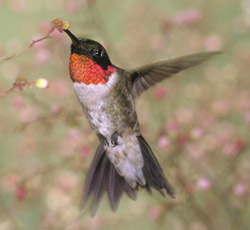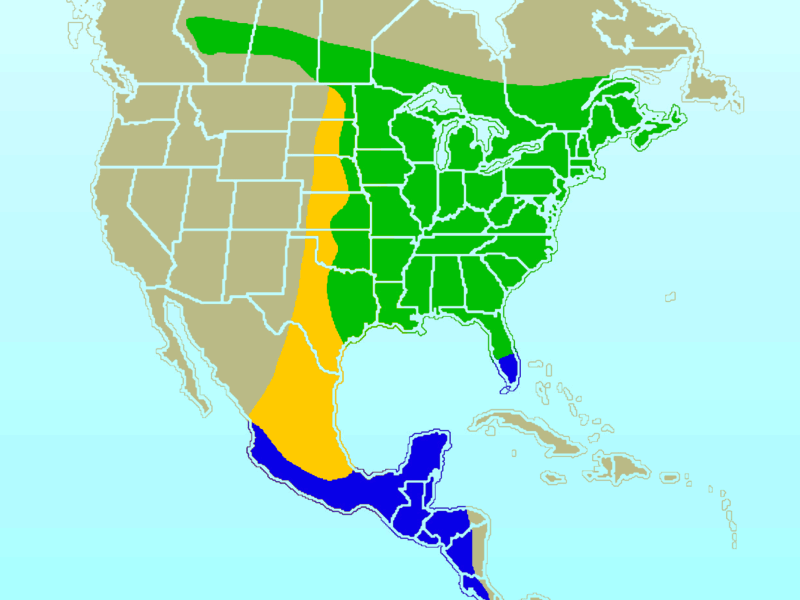- Ruby-throated Hummingbird
Taxobox
name = Ruby-throated Hummingbird
status = LC
status_system = iucn3.1

image_width = 220px
regnum =Animal ia
phylum = Chordata
classis = Aves
ordo =Apodiformes [ [http://www.birds.cornell.edu/AllAboutBirds/BirdGuide/Ruby-throated_Hummingbird_dtl.html All About Birds: Ruby-throated Hummingbird ] ]
familia =Trochilidae
genus = "Archilochus"
species = "A. colubris"
binomial = "Archilochus colubris"
binomial_authority = (Linnaeus, 1758)
range_
range_map_width = 220px
range_map_caption = Green: summer-only range
Blue: winter-only range
Orange: migratory path
synonyms ="Trochilus colubris"The Ruby-throated Hummingbird ("Archilochus colubris"), is a small
hummingbird . It is the only species of hummingbird that regularly nests east of theMississippi River inNorth America .Description
The Ruby-Throated Hummingbird is 7-9 cm long with an 8-11 cm wingspan, and weighs 2-6 g. Adults are metallic green above and greyish white below, with near-black wings. Their bill is long, straight and very slender.
The adult male, shown in the photo, has an
iridescent ruby red throat patch which may appear black in some lighting, and a dark forked tail. The female has a dark rounded tail with white tips and generally no throat patch, though she may sometimes have a light or whitish throat patch.The male is smaller than the female, and has a slightly shorter beak. A molt of feathers occurs once per annum, and begins during the autumn migration.
Habitat and range
The breeding habitat is throughout most of eastern North America and the Canadian
prairie s, in deciduous and pine forests and forest edges, orchards, and gardens. The female builds a nest in a protected location in a shrub or a tree.The Ruby-throated Hummingbird is migratory, spending most of the winter in southern
Mexico ,Central America as far south asSouth America , and theWest Indies . It breeds throughout the eastern United States, east of the 100th meridian, and in southern Canada in eastern and mixed deciduous forest.cite web
last =Harris | first =M.
coauthors =R. Naumann and K. Kirschbaum.
title ="Archilochus colubris"
publisher =University of Michigan Museum of Zoology
url =http://animaldiversity.ummz.umich.edu/site/accounts/information/Archilochus_colubris.html
accessdate = 2007-08-24 ]Behavior
Ruby-throated hummingbirds are
solitary . Adults of this species typically only come into contact for the purpose of mating, and both males and females of any age aggressively defend feeding locations within their territory. The aggressiveness becomes most pronounced in late summer to early fall as they fatten up for migration.They feed frequently while active during the day and when temperatures drop, particularly on cold nights, they may conserve energy by entering
hypothermic .Due to their small size, they are vulnerable to insect-eating birds and animals.
Flight
Hummingbirds have many skeletal and flight muscle adaptations which allow the bird great agility in flight. Muscles make up 25-30% of their body weight, and they have long, blade-like wings that, unlike the wings of other birds, connect to the body only from the shoulder joint. This adaptation allows the wing to rotate almost 180°, enabling the bird to fly not only forward but also straight up and down, sideways, and backwards, and to hover in front of flowers as it feeds on nectar and insects.
During hovering, ruby-throated hummingbird wings beat 55x/sec, 61x/sec when moving backwards, and at least 75x/sec when moving forward.
Diet
Nectar from
flower s and flowering trees is its main food, but its diet also occasionally includes insects and tree sap taken from woodpecker drilling. It shows a slight preference for red,tubular flowers as anectar source. The birds feed from flowers using a long extendable tongue, or catchinsect s on the wing.Young birds are fed
insects forprotein since nectar is an insufficient source of protein for the growing birds. [Robinson, T. R., R. R. Sargent, and M. B. Sargent. 1996.]Reproduction
Ruby-throated hummingbirds are thought to be
polygynous .Polyandry andpolygynandry may also occur. They do not form breeding pairs, and females provide all parental care.Males arrive at the breeding area in the spring, and establish a
territory before the females arrive. When the females return, males court females that enter their territory by performing courtship displays. They perform a “dive display” rising 8 to 10 feet above and 5 to 6 feet to each side of the female. If the female perches, the male begins flying in very rapid horizontalarc s less than 0.5 m in front of her. The male's wings may beat up to 200 times per second during these displays (the normal speed is 55-75 beats per second).If the female is receptive to the male, she may give a call and assume a solicitous posture with her tail feathers cocked and her wings drooped. Preceding copulation, male and female face each other, alternately ascend about 10 feet and descend, eventually dropping to the ground and copulating. [ [http://www.birding.com/topbirds/2080rth.asp Ruby-throated Hummingbird (Archilochus colubris) | birding .com ] ]
The nest is constructed on a small, downward-sloping tree limb 10-20 feet above the ground. It is composed of
bud scales, withlichen on the exterior, bound withspider 's silk, and lined with plant down (oftendandelion orthistle down). Old nests may be occupied for severalseason s, but are repaired annually. The female constructs the nest, as the male has left by this point. [ [http://animaldiversity.ummz.umich.edu/site/accounts/information/Archilochus_colubris.html ADW: Archilochus colubris: Information ] ]Females lay two white eggs about 12.9 by 8.5 millimeters in size, and produce 2, or occasionally 3 broods. They
brood the chicks and feed them from 1 to 3 times every hour by regurgitation, usually while the female is hovering. When they are 22 to 25 days old, the young leave the nest.(0.5 x 0.3 in).Vocalization
The vocalizations of Ruby-throated Hummingbirds are rapid, squeaky chirps, and are used primarily for threats. For example, males may vocalize to warn another male that has entered his territory.
Listen
filename=Archilochus colubris.ogg
title="Archilochus colubris" call
description=Bird call of the Ruby-throated Hummingbird ("Archilochus colubris")
format=Ogg
=References
* Database entry includes justification for why this species is of least concern
* Interesting Ruby-throated Hummingbird Facts donated by [http://www.birdhouses101.com/ruby-throated-hummingbird.asp BirdHouses101.com]
* http://www.rubythroat.org/RTHUExternalMain.html
* http://www.hummingbirds.net/rubythroated.htmlExternal links
* [http://www.youtube.com/watch?v=I1kJm_0A-CE Ruby-throated Hummingbird Nest Cycle]
* [http://www.birds.cornell.edu/AllAboutBirds/BirdGuide/Ruby-throated_Hummingbird.html Ruby-throated Hummingbird] - Cornell Lab of Ornithology
* [http://www.mbr-pwrc.usgs.gov/id/framlst/i4280id.html Ruby-throated Hummingbird Information] - USGS Patuxent Bird Identification InfoCenter
* [http://www.sdakotabirds.com/species/ruby_throated_hummingbird_info.htm Ruby-throated Hummingbird Information and Photos] - South Dakota Birds and Birding
* [http://juliesmagiclightshow.com/index.php?pic=776 Ruby-throated hummingbird at feeder (animation)]
* http://www.rubythroat.org - "Operation RubyThroat: The Hummingbird Project"
* http://www.hummingbirdsociety.org/photogallery - photographs of this and other hummingbird species
* [http://www.birdwatching-bliss.com/ruby-throated-hummingbird.html All about the Ruby-throated Hummingbird]
* [http://www.dyesscreek.com/miscellaneous_pages/hummingbird_photography.html How to Photograph Hummingbirds - including many photos of this species]
* [http://www.hummingbirds.net/map.html migration map (US and Canada only)]
* [http://earthobservatory.nasa.gov/Newsroom/NewImages/images.php3?img_id=17589 2007 spring migration]
* [http://www.bird-stamps.org/cspecies/8631500.htm Stamps]
* [http://ibc.hbw.com/ibc/phtml/especie.phtml?idEspecie=3284 Ruby-throated Hummingbird videos] on the Internet Bird Collection
* [http://rthu.com/ Videos of Ruby Throated Hummingbirds]
* [http://www.projetcolibris.org/English Research project on the Ruby-throated hummingbird in Québec]
Wikimedia Foundation. 2010.
